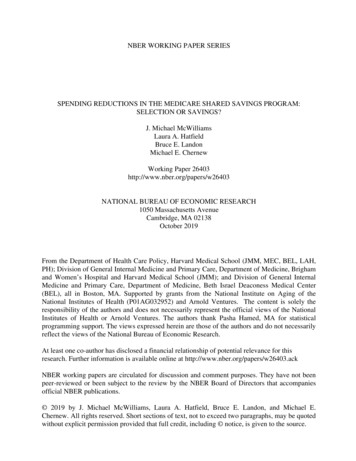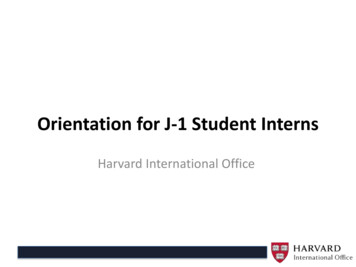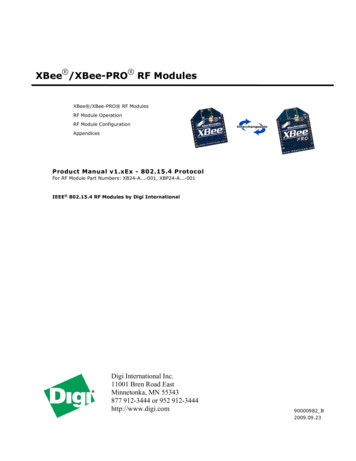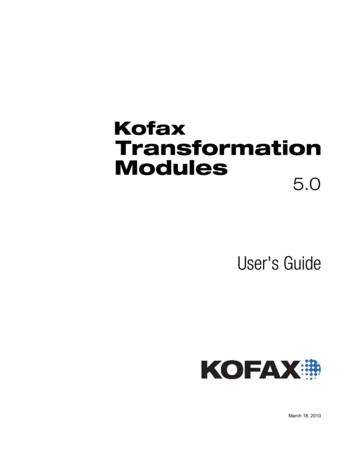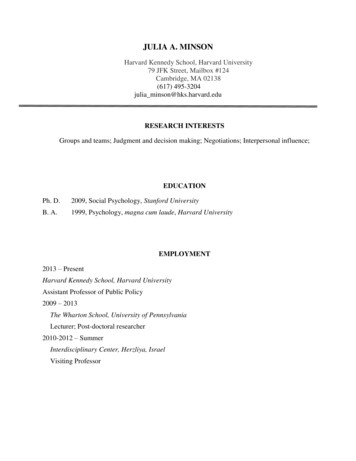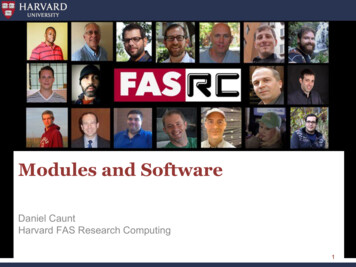
Transcription
Modules and SoftwareDaniel CauntHarvard FAS Research Computing1
What is Research Computing?Faculty of Arts and Sciences (FAS) department that handlesnon-enterprise IT requests from researchers. (Contact HUIT for mostDesktop, Laptop, networking, printing, and email issues.) RC Primary Services:––––Odyssey Supercomputing EnvironmentLab StorageInstrument Computing SupportHosted Machines (virtual or physical) RC Staff:– 20 staff with backgrounds ranging from systems administration todevelopment-operations to Ph.D. research scientists.– Supporting 600 research groups and 3000 users across FAS, SEAS,HSPH, HBS, GSE.– For bio-informatics researchers the Harvard Informatics group is closelytied to RC and is there to support the specific problems for that domain.2
3
4
Objectives Feel knowledgeable about computational and softwareenvironment Understand LMOD software module files Know how to handle different types and versions ofsoftware applications Customize libraries for common scripting languages,such as R, Python and Perl Understand basics on version control Enable you to “Work smarter, better, faster”5
Environment basicsOverview Software module system (LMOD) and software modules Installing Java, Python, R and Perl applications Installing and updating local packages Version control Using precompiled software libraries6
Environment basicsWhen you login, Unix executes certain steps for your interactive sessions Startup files are read Command prompts are set up Aliases expandedStartup files set up default values for your environment /etc/profile .bash profile .bash login .profile .bashrcThe only things that really need to be in .bash profile are environment variables and their exports and commands these aren’t definitions but actually run or produce output when you loginOption and alias definitions should go into the environment file .bashrc7
Environment basics - .bash profile[pkrastev@sa01 ] cat .bash profile# .bash profile# Get the aliases and functionsif [ -f /.bashrc ]; then. /.bashrcfi# User specific environment and startup programsexport PATH PATH: HOME/bin8
Environment basics - .bashrc[pkrastev@sa01 ] cat .bashrc# .bashrc# Source global definitionsif [ -f /etc/bashrc ]; then. /etc/bashrcfi# User specific aliases and functionsalias ls “ls --color auto”# LMOD set upfunction loadmodules() {source new-modules.shmodule load intel/15.0.0-fasrc01module load intel-mkl/11.0.0.079-fasrc02module load openmpi/1.8.3-fasrc02module load hdf5/1.8.12-fasrc06module load matlab/R2015b-fasrc01module load totalview/8.8.0.1-fasrc01}9
LMOD Module System (1)LMOD: ENVIRONMENTAL MODULES ment/tacc-projects/lmodEnvironment Modules provide a convenient way to dynamically change the user’senvironment through module files (Lua-based scripting files). This includes easilyadding or removing directories to the PATH environment variable.A module-file: Contains the necessary information to allow a user to run a particular applicationor provide access to a particular library. Dynamically changes environmentwithout logging out and back in Applications modify the user's path to make access easy Library packages provide environment variables that specify where the libraryand header files can be foundPackages can be loaded and unloaded cleanly through the module system. All the popular shells are supported: bash, ksh, csh, tcsh, zsh Also available for perl and python It is also very easy to switch between different versions of a software package orremove it.10
LMOD Module System (2)Software is loaded incrementally using modules, to set up your shell environment (e.g., PATH,LD LIBRARY PATH, and other environment variables)Using the Harvard-modified, TACC module system LMOD: Strongly suggested reading: http://fasrc.us/rclmodsource new-modules.shmodule load matlab/R2016a-fasrc01# loads LMOD environment# recommendedmodule load matlabmodule-query matlabmodule-query matlab/R2016a-fasrc01# most recent version# find software modules# gives more detailsmodule spider matlab# finds details on softwaremoduleavail2 &1 grep-i matlab# larto module-queryare alsoavailable on the RC lesModule loads best placed in SLURM batch scripts: Keeps your interactive working environment simple Is a record of your research workflow (reproducible research!) Keep .bashrc module loads sparse, lest you run into software and library conflicts11
Modules: How do they work? (1)[pkrastev@sa01 ] module load gcc/6.1.0-fasrc01[pkrastev@sa01 ] which cc[pkrastev@sa01 ] ll /n/sw/fasrcsw/apps/Core/gcc/6.1.0-fasrc01/total 2166drwxr-xr-x 2 root root 1180 Jul 6 17:31 bin-rw-r--r-- 1 root root 593769 Apr 27 04:20 ChangeLog-rw-r--r-- 1 root root 18002 Jul 13 2005 COPYINGdrwxr-xr-x 3 root root 21 Jul 6 17:29 includedrwxr-xr-x 2 root root 356 Jul 6 17:29 INSTALLdrwxr-xr-x 5 root root 3091 Jul 6 17:30 libdrwxr-xr-x 6 root root 3551 Jul 6 17:30 lib64drwxr-xr-x 3 root root 21 Jul 6 17:30 libexec-rw-r--r-- 1 root root 2625 Jul 6 17:12 modulefile.lua-rw-r--r-- 1 root root 764169 Apr 27 04:23 NEWS-rw-r--r-- 1 root root 1026 Jul 16 2012 READMEdrwxr-xr-x 7 root root 115 Jul 6 17:31 share12
Modules: How do they work? (2)[pkrastev@sa01 ] cat ualocal helpstr [[gcc-6.1.0-fasrc01the GNU Compiler Collection version 6.1.0]]help(helpstr,"\n")whatis("Name: gcc")whatis("Version: 6.1.0-fasrc01")whatis("Description: the GNU Compiler Collection version 6.1.0")---- prerequisite apps (uncomment and tweak if necessary)for i in string.gmatch("gmp/6.1.1-fasrc02 mpfr/3.1.4-fasrc02 mpc/1.0.3-fasrc04","%S ") doif mode() "load" thena string.match(i," [ /] ")if not isloaded(a) thenload(i)endendend---- environment changes (uncomment what is relevant)setenv("CC" , "gcc")setenv("CXX", "g ")setenv("FC" , "gfortran")setenv("F77", "gfortran")prepend rc01/bin")prepend src01/include")prepend src01/include")prepend path("LD LIBRARY PATH", epend path("LIBRARY ib”)13
Modules: Hierarchies (1)Use of groupings is important for proper functioning programs. Libraries built with one compiler need to be linked with applications withthe same compiler version. For High Performance Computing there are libraries called MessagePassing Interface (MPI) that allow for efficient communicating betweentasks on a distributed memory computers with many processors. Parallel libraries and applications must be built with a matching MPIlibrary and compiler.Instead of using a flat namespace, we can use module hierarchies. Simple technique because once users choses a compiler and MPIimplementation, they can only load modules that match that compiler andMPI implementation. FASRC follow's TACC's convention: MODULEPATH ROOT/{Core,Comp,MPI} #/n/sw/fasrcsw/modulefiles14
Modules: Hierarchies (2)[pkrastev@sa01 ] module-query ----------Description:HDF5 is a data model, library, and file format for storing and managing data. It supports an unlimited variety of datatypes, and is designedfor flexible and efficient I/O and for high volume and complex data. HDF5 is portable and is extensible, allowing applications to evolve intheir use of HDF5. The HDF5 Technology suite includes tools and applications for managing, manipulating, viewing, and analyzing data inthe HDF5 format. HDF5 is used as a basis for many other file formats, including NetCDF.Versions:hdf5/1.8.17-fasrc01. MPIhdf5/1.8.16-fasrc03. MPIhdf5/1.8.16-fasrc02. MPIhdf5/1.8.16-fasrc01. MPIhdf5/1.8.15patch1-fasrc01. MPIhdf5/1.8.14-fasrc01. MPIhdf5/1.8.12-fasrc12. MPIhdf5/1.8.12-fasrc08. Corehdf5/1.8.12-fasrc07. MPIhdf5/1.8.12-fasrc06. MPIhdf5/1.8.12-fasrc05. MPIhdf5/1.8.12-fasrc04. Corehdf5/1.8.12-fasrc04. MPIhdf5/1.8.12-fasrc03. MPIhdf5/1.8.12-fasrc02. MPIhdf5/1.8.12-fasrc01. MPITo find detailed information about a module, enter the full name.For example,module-query hdf5/1.8.12-fasrc0115
Modules: Hierarchies (3)[pkrastev@sa01 ] module-query ---------hdf5 : ---------Description:HDF5 is a data model, library, and file format for storing and managing data. It supports an unlimited variety ofdatatypes, and is designed for flexible and efficient I/O and for high volume and complex data. HDF5 is portable andis extensible, allowing applications to evolve in their use of HDF5. The HDF5 Technology suite includes tools andapplications for managing, manipulating, viewing, and analyzing data in the HDF5 format. HDF5 is used as a basisfor many other file formats, including NetCDF.This module an be loaded as follows:module load gcc/6.1.0-fasrc01 openmpi/1.10.3-fasrc01 hdf5/1.8.16-fasrc03module load gcc/6.1.0-fasrc01 mvapich2/2.2rc1-fasrc01 hdf5/1.8.16-fasrc03module load intel/15.0.0-fasrc01 openmpi/1.10.3-fasrc01 hdf5/1.8.16-fasrc03module load intel/15.0.0-fasrc01 mvapich2/2.2rc1-fasrc01 hdf5/1.8.16-fasrc03This module also loads:zlib/1.2.8-fasrc07 szip/2.1-fasrc0216
Java Programs Download the *.jar files or the install files into a home or lab apps/ or bin/directoryInclude the java CLASSPATH statement in your .bashrc, ORSet up a bash environment variable in your .bashrcCall the software using the java command, pointing to the appropriateroutinecd mkdir –p apps; cd appswget http:// longURL /Trimmomatic-0.36.zipunzip Trimmomatic-0.36.zipln –s Trimmomatic-0.36 trimmomaticecho "export TRIMMOMATIC HOME/apps/trimmomatic" /.bashrc# in SLURM script or on command line module load java/1.8.0 45-fasrc01cd /myFASTQdirectory; mkdir trimmed# minHeap (-Xms) and maxHeap (-Xmx) options are optional but useful in some cases!!java -Xms128m –Xmx4g -jar TRIMMOMATIC/trimmomatic-0.32.jar SE -threads 1 \PSG177 TGACCA.fastq.gz trimmed/PSG177 TGACCA.fastqILLUMINACLIP:TruSeq3-PE.fa:2:40:15 LEADING:3 TRAILING:3 \SLIDINGWINDOW:4:20 MINLEN:2517
Python ProgramsFor Python we recommend: Use the standard “module load python/2.7.6-fasrc01” for pulling in default modules Use the Anaconda environment for customizing modules & versions Multiple custom environments can be set up for home or lab folders (e.g. development orproduction code). Check conda options for “non-standard” locations /software-on-odyssey/python# Load modulemodule load python/2.7.6-fasrc01# Create local python environment in /.conda/envs/ENV NAMEconda create -n ENV NAME --clone " PYTHON HOME”# Use the new environmentsource activate ENV NAME# Install a new package named MYPACKAGEconda install MYPACKAGE# If the package is not available with conda use pippip install MYPACKAGE# If you have problems updating a package first remove itconda remove PACKAGE18
R ProgramsWhen loading R from the LMOD software module system, 100s of commonpackages have already been installed.Use the R LIBS USER environment variable to specify local R sources/documentation/software-on-odyssey/r# Load R module, e.g.,module load R/3.2.0-fasrc01# Set R LIBS USER to your location for R packages, e.g.,export R LIBS USER HOME/apps/R: R LIBS USER# Start RR# Inside R, install the desired package, e.g., install.packages(“Rcpp”)19
Perl Programs# load Perl, default modules, and set local installmodule load perl/5.10.1-fasrc04module load perl-modules/5.10.1-fasrc11# can put these in your .bashrcexport LOCALPERL HOME/apps/perl# dir must already existexport PERL5LIB LOCALPERL: LOCALPERL/lib/perl5: PERL5LIBexport PERL MM OPT "INSTALL BASE LOCALPERL"export PERL MB OPT "--install base LOCALPERL"export PATH " LOCALPERL/bin: PATH"# and now do easy, local installs with cpan, e.g.,cpan FASTAParse20
Using Software LibrariesLibraries allow you to pull in pre-compiled functions and code to your programsMany are already installed on the cluster, e.g., GSL, BLAS, LAPACK, NetCDF,HDF5, FFTW, MKL, BOOST, and can be loaded as software modulesmodule load gsl/1.16-fasrc02This will set up environmental variables, such as PATH, LD LIBRARY PATH,LIBRARY PATH, and CPATHLibraries may also be part of the OS/lib, /lib64Linking to specific libraries can be done by setting -l and -L flags, e.g.,gfortran -o my executable.x my source.f90 -lblas –llapackifort –my executable.x my source.f90 -I {HDF5 INCLUDE} \-L {HDF LIB} -lhdf5 -lhdf5 fortranhttps://github.com/fasrc/User Codes/tree/master/Libraries21
Version ControlVersion control is a system that records changes to a file or set of files over timeso that you can recall specific versions later. Typically used for source code files In reality you can do this with nearly any type of file on a computer22
Request Help - Resources https://rc.fas.harvard.edu/resources/support/– Documentation /– Portal http://portal.rc.fas.harvard.edu/rcrt/submit ticket– Email rchelp@fas.harvard.edu– Office Hours Wednesday 12-3pm 38 Oxford - 206 @HSPH every other Tuesday 2:00-3:30 pm– Training https://www.rc.fas.harvard.edu/training/Slide 23
Questions ?Daniel CauntHarvard FAS Research Computing24
Desktop, Laptop, networking, printing, and email issues.) RC Primary Services: - Odyssey Supercomputing Environment - Lab Storage - Instrument Computing Support - Hosted Machines (virtual or physical) RC Staff: - 20 staff with backgrounds ranging from systems administration to development-operations to Ph.D. research scientists.


